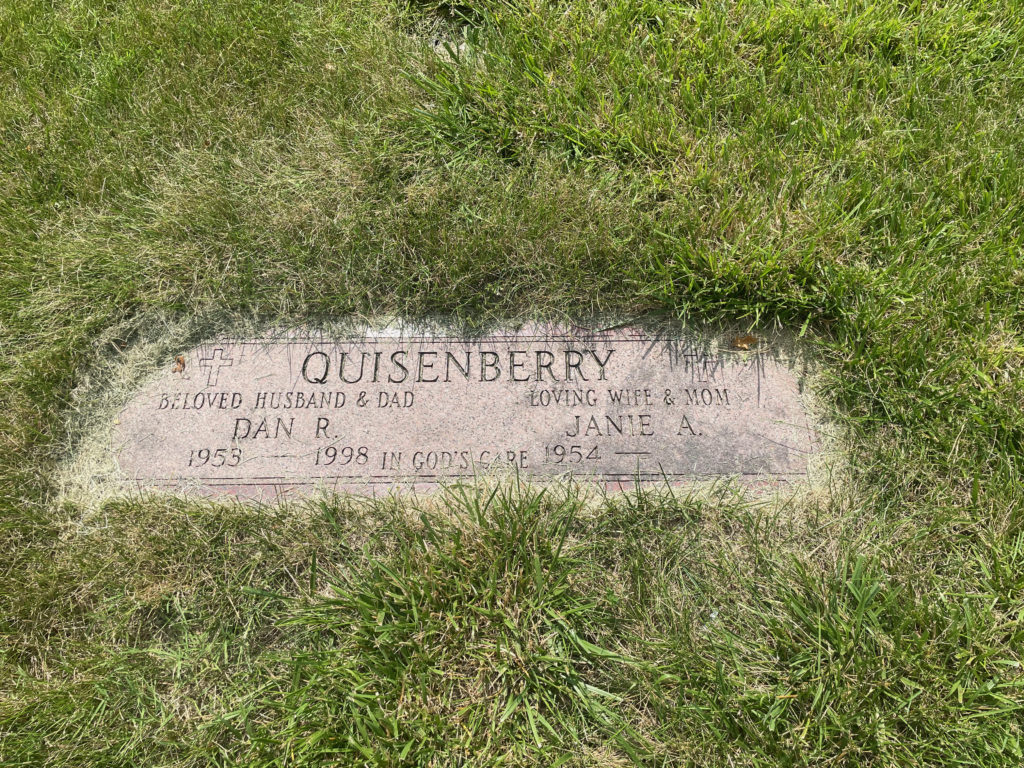Erik Visits an American Grave, Part 944
This is the grave of Dan Quisenberry.

Born in 1953 in Santa Monica, California, Quisenberry grew up in a baseball family. His parents divorced when he was young his mother remarried an engineer who loved the game and encouraged his stepson to play. Well, that was a pretty good call. He was kind of a marginal prospect out of high school, went to junior college and then some Christian school called University of La Verne. He wasn’t even drafted, but the Kansas City Royals signed him as a free agent in 1975. He started in the minors and in fact threw a complete game in his first start with the Single-A team in Waterloo, Iowa. But he was switched to the bullpen as he rose through the minors. He was honestly just a guy. All the minor league teams have them, dudes with mediocre stuff that plays but might not play in the majors. Maybe they get a chance to move up, maybe they don’t. Quisenberry did, but Royals management openly said after he became so good that they were shocked and that he really didn’t have any champions in the organization who thought he would become a guy. Even his former minor league teammates like Willie Wilson later remarked he didn’t see Quisenberry as a major league pitcher until he actually got to the major leagues.
Quisenberry first reached the big leagues with the Royals in 1979. He was already a pretty good reliever for them even as a rookie. But his fastball was bad. He really didn’t have a good out pitch. And how effective and long-lasting would a junkballer be? So his manager Jim Frey suggested he learn the submarine arm angle from Kent Tekulve, who was a master of it. Quisenberry picked this up quickly and soon became the American League’s most dominant reliever. He led the AL in saves in 1980 with 33. He was 5th in the Cy Young voting that year. 1981 was the strike year, but he was great that year too. Between 1982 and 1985, he led the league in saves every year and finished in the top 5 in the Cy Young voting every year too, including finishing second in both 1983 and 1984. Baseball Reference’s WAR is not super kind to relievers because how much value does a guy pitching 1 or 2 innings really offer. But in 1983, he had a 5.5 WAR which is really amazing for a closer. That was his best year by this metric, with a 4.2 RAR in 1985 his second best year. In 1983, his 45 saves was the all time single season record, even if Bruce Sutter would tie that the next year and Dave Righetti would break it in 1986. He never was a strikeout guy, which is hard to imagine today given the dominant fastballs of modern relievers. But his submarine pitch and general junk encouraged lots of hitting the ball into the ground for easy outs.
Quisenberry became a Royals legend, perhaps second only to George Brett at the time, though Willie Wilson, Frank White, and Bret Saberhagen were also excellent players on those mid-80s teams. He was such a fascinating character that the great Roger Angell (still alive and well at 101!) wrote a big profile of him for The New Yorker in 1985. But in 1988, Quisenberry’s stuff began to slip and he lost the closer job completely, though he was pitching more middle relief in 1986 and 1987 too. The Royals released him in the middle of the season in 1988. He was immediately signed by the St. Louis Cardinals. He was a useful middle reliever there for the next year and a half. He attempted to extend his career by pitching for the Giants in 1990, but was terrible in a few games and then tore his rotator cuff, ending his time on the diamond. He presently is tied with Mark Melancon for 38th all time with 245 saves
After retirement, Quisenberry moved back to Kansas City and raised his kids with his wife. They were devout Christians. He also started publishing poetry. In 1998, he and his family were vacationing in Colorado, when he complained about being sick. Turned out he had an advanced case of brain cancer. There was nothing the doctors could do. He died later that year, at the age of 45.
Dan Quisenberry is buried in Mount Moriah Cemetery, Kansas City, Missouri.
If you would like this series to visit other closers, you can donate to cover the required expenses here. The save is such a recent statistic that not that many leading closers are actually dead. Rod Beck, who is 34th on the all time save list and is the highest person on that list to no longer be with us, is in Scottsdale, Arizona and Hoyt Wilhelm, the one time career leader in saves who is now 43rd, is in Sarasota, Florida. Previous posts in this series are archived here.


